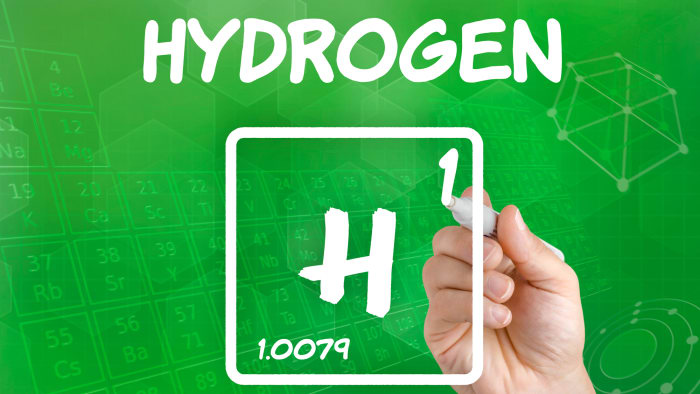Hydrogen’s characteristics, properties, and interactions with oxygen
The lightest element

Hydrogen is a chemical element located simultaneously in two groups of the Periodic Table of elements, indicative of opposite properties. It can form a simple substance, and can additionally be a component of many compounds.
Hydrogen’s chemical characteristics
Hydrogen is a chemical element located in subgroup A of the first group, and in subgroup A of the seventh group in the first period.

Hydrogen’s main properties, as can be determined from its position as the first element in the periodic table, are as follows:
- hydrogen has an atomic number of 1, and has 1 electron and 1 proton;
- hydrogen’s atomic mass is 1.008. Hydrogen has 3 isotopes with masses of 1, 2, and 3. Their properties are very different – for hydrogen, even adding just one AMU (atomic mass unit) means doubling its mass;
- as its outer level only contains 1 electron, hydrogen has both oxidative and reductive properties. If it surrenders its electron, hydrogen is left with a free orbital, which can form chemical bonds according to a donor-acceptor mechanism;
- hydrogen is a good reducer, and so is in subgroup A of the first group;
- when interacting with strong reducers (such as alkali metals), hydrogen becomes an oxidizer, accepting an electron. These compounds are called hydrides. Due to this property, hydrogen conventionally belongs to the halogen group;
- hydrogen’s low atomic mass makes it the lightest element. As such, hydrogen is recognized as a standard of lightness.
Hydrogen is a chemical element unlike any other, with special properties of enormous significance.
Physical properties of hydrogen
Hydrogen as a pure substance has the following physical parameters:
- a melting point of -259.2°C;
- a boiling point of -252.8°C;
- from (-259.2°C) to (-252.76°C), hydrogen is a colorless, odorless liquid;
- liquid hydrogen can severely freeze the skin upon contact;
- in normal conditions, hydrogen is a colorless, odorless, tasteless gas that is both combustible and explosive;
- at high pressures, hydrogen forms solid, snow-like crystals;
- in special conditions, hydrogen is capable of assuming a metallic state;
- hydrogen is insoluble in water, so it can be obtained in a laboratory setting via the electrolysis of water (the decomposition of water into oxygen and hydrogen);
- it dissolves well in some metals because of its ability to diffuse through them;
- hydrogen is 14.5 times lighter than air;
- its crystal structure is molecular and breaks down easily due to weak bonds between the lattice nodes.
Hydrogen’s reactions with simple substances
When hydrogen is heated, a combination reaction takes place between the element and simple substances such as chlorine, sulfur, and nitrogen. The following is a common demonstration of the reaction between hydrogen and oxygen:
A stream of pure hydrogen released from a gas tube is ignited in air, and the gas burns with an even, almost unnoticeable flame. The stream of burning hydrogen is then directed into a flask containing oxygen. The hydrogen continues to burn, and the walls of the flask are covered with drops of water that form as a result of the reaction between hydrogen and oxygen. The combustion of hydrogen is accompanied by the release of a large amount of heat. The temperature of the hydrogen-oxygen flame reaches over 2,000 °C.
The chemical reaction of hydrogen with oxygen is a combination reaction that produces water and moreover is an oxidation-reduction reaction: oxygen oxidizes hydrogen.
If you collect hydrogen in an upside-down test tube, having removed the air, and bring a burning match to the test tube neck, the mixture of hydrogen and air will explode with a loud report. This is called a “detonating” mixture.
As mixing hydrogen and oxygen results in oxyhydrogen, there have been accidents involving airships inflated with hydrogen. When such a dirigible's hermetic seal is broken, a single spark can cause an explosion. For this reason, modern airships are filled with helium or constantly-heated air.

Hydrogen — reaction with oxygen
As we know, a mixture of hydrogen and oxygen forms oxyhydrogen — an explosive mixture. Oxyhydrogen is most explosive at a hydrogen:oxygen ratio of 2:1, also known as Brown's Gas, or 2:5 for hydrogen and air.
Hydrogen gas is highly flammable and will burn in air at an extremely wide range of concentrations (between 4% and 75% by volume). Consequent studies on the reaction between oxygen and hydrogen have ascertained that large volumes of hydrogen can be explosive even at small concentrations. In other words, the greater the volume of hydrogen, the lower the concentration required for an explosion.
Initially, the explosive nature of hydrogen was studied in laboratories with small amounts of the substance. As the reaction of hydrogen with oxygen is a chemical chain reaction that takes place according to the free radical mechanism, the termination of free radicals on the walls of chemical vessels is critical for continuing the chain. If there is a chance of formation of a limiting concentrations of hydrogen in large volumes (for example in sheds, warehouses or factory facilities), we should note that a truly explosive concentration of oxygen with hydrogen may be either slightly more or less than 4%. At present, scientists are researching hydrogen’s relatively-unexplored propensity to spontaneously combust from a drastic drop in pressure.